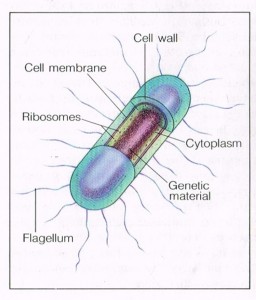February 25 Powerpoint: February 25 Kingdom Monera
February 29 Powerpoint: February 29 Kingdom Monera (cont’d)
Learning Objectives
- Identify and label structures of a generic Moneran
- Identify and Describe the four criteria through which Moneran are classified
- Describe the ways in which Moneran obtain/metabolize energy
- Describe the three ways Moneran reproduce
Kingdom Monera is a large, diverse and wholly under-appreciated group of organisms. They perform many critical functions in the ecosystem, such as detritivores. They are used in the food industry for production of foods, such as milk or cheese. They are also responsible for many human diseases, such as the black plague that destroyed a third of the European population in the 14th century.
Members of this kingdom are also called bacteria.
Generally, bacteria all share some common features.
Structure of generic Monera
- All Monera are unicellular and prokaryotic
- No nucleus. DNA or RNA and ribosomes floating in cytoplasm.
- Cell membrane made of lipids
- Cell wall made of peptidoglycan to protect cell
- Flagellum (plural: flagella) to move
Ways to classify a Moneran
Because of their small size, bacteria are very hard to observe under the microscope. Even when their individual shape or form can be seen, many look far too alike to definitively classify. Thankfully, we do have ways to classify Monera.
- Shape – Almost all Monera fit into one of three shapes: round and spherical (cocci), long and rod shaped (bacilli) and spiral shaped (spirilla). Cells can also be classified based on their clustering behavior. Some cluster into colonies and strings, while others are primarily solitary.
- Gram stains – because bacteria are for the most part, transparent to the naked eye, they must be stained to be properly observed under the microscope. When Hans Christian Gram, a Danish bacteriologist was staining bacteria with crystal violet, he realized that some bacteria retained the stains and became purple, while some did not and became pink. As it turns out, this has to do with the thickness and structure of the peptidoglycan cell wall. Generally, a thicker cell wall will retain more of the crystal violet, while thin ones will not.
- Bacteria movement – some bacteria have flagella, whip like projections, that allow them to move. Some bacteria secrete slime to move along like a slug. Still others don’t move at all.
- DNA/RNA Sequencing – the most specific way to identify a bacteria is probably through DNA/RNA sequencing. We do so by identifying the genes of the bacteria, which is probably fairly specific to each species. This method has become more common in recent years as the cost of genome sequencing decreases.
Ways Moneran get their energy
It should be noted that the following terms describe where organisms (any organism, not just bacteria) get their energy from.
- Phototrophic Autotroph: organisms that derive their energy from the sun
- Chemotrophic Autotroph: organisms that derive their energy from inorganic chemicals (chemicals that are not derived from living things)
- Chemotrophic Heterotroph: (aka heterotrophs) are organisms that derive their energy from organic chemicals (chemicals that are derived from living things)
- Phototrophic Heterotroph: are organisms that derive their energy from organic chemicals or the sun, depending on which source is available
————- (End of Thursday, February 25) ——————-
Ways Monerans Metabolize their energy
Depending on whether the Moneran uses one or both of the following
1. Cellular Respiration – a series of chemical reactions that uses sugars and oxygen to produce energy.
2. Fermentation – a series of chemical reactions that converts sugars to acids, gases or alcohol, and produces energy. It occurs without oxygen.
we classify monerans as follows.
- Obligate Aerobes: Monerans that need oxygen in order to produce energy (aerobic respiration). These Monerans mainly use cellular respiration.
- Obligate Anaerobes: Monerans that will die in the presence of oxygen, as oxygen is toxic to these monerans. These Monerans mainly use fermentation.
- Facultative Anaerobe: Monerans that can produce energy in oxygen (cellular respiration), but switch to fermentation if there is no oxygen.
Ways Monerans Reproduce
- Binary fission – where the cell replicates its DNA, and splits into two daughter cells, where each daughter cell gets one set of DNA
- Conjugation – the bacterial form of sexual reproduction. Involves the exchange of genetic information.
- Spore Formation – strictly speaking, not a form of reproduction. Occurs when a bacterium produces a hard covering (spore) and becomes metabolically inactive to preserve itself in adverse environments.
Bacteria Research Mini-Project – One page fact sheet on an assigned bacterium – DUE TUESDAY FEBRUARY 1st

